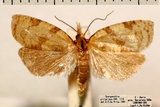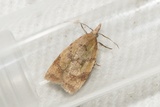Sparganothis pilleriana ([Denis & Schiffermüller], 1775) Species
Last modified: Oct. 14, 2025, 2:59 p.m.
A very rare and local species in Belgium.
Details
- Classification
- Family: Tortricidae > Subfamily: Tortricinae > Tribus: Sparganothini > Genus: Sparganothis > Species: Sparganothis pilleriana
- Vernacular names
- Puntsnuitbladroller (NL), Vine Leaf-roller Tortrix, Long-nosed Twist (EN), Pyrale de la vigne, Ver de la vigne (FR), Laubwurm, Springwurm-Wickler (DE)
- First mention in Belgium
- Fologne E. 1860. Lépidoptères et chenilles observés en Belgique. — Annales de la Société entomologique belge 4: 108–112. On page 108.
- Status
-
Native
Distribution
Imago
Wingspan male 15–20 mm, female 17–22 mm. Readily recognised by its long, porrect labial palpi.
The male is variable but is generally yellowish to greyish/brown with brown markings. The most noticeable being a diagonal band from the costa to the dorsum.
The female is generally a uniform reddish/brown.
Egg
Eggs are flat, oval, initially apple green, later becoming citreous and finally orange-yellow.
Caterpillar
Length of mature larva is 18-30 mm, greenish-grey or dirty-green, lighter beneath, with head and pro-thorax dark brown.
Cocoon/pupa
The pupa is dark brown with a long cremaster containing two lateral and two terminal bristles.
Bionomics
Eggs are laid in batches containing 40–100 eggs covered by a gland secretion hardening in the air.
Larvae hatch after 10 days and enter diapause almost immediately, hiding in bark crevices. They resume their activity only when the first leaves appear next spring, migrating to the top of the branches and feeding on buds initially and on leaves later. They exhibit typical territorial behaviour, marking and defending their territories with knocking sounds.
Pupation takes place in a shelter between spun leaves or a rolled leaf.
Flight periods
Moths fly in one generation from July to August.
Observed on
- Host plant (species):
- Vitis vinifera, Medicago sativa, Sambucus nigra and Salix repens
- Host plant (genera):
- Fragaria, Malus, Centaurea, Clematis, Castanea, Crataegus, Humulus, Iris, Limonium, Origanum, Plantago, Pyrus and Stachys
- Substrates:
- Herbaceous plants
The larva is highly polyphagous on a high number of trees, shrubs and herbaceous plants and causes occasional but serious damage to grapevines, strawberries and other fruits.


